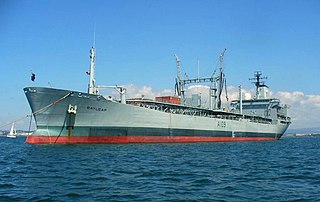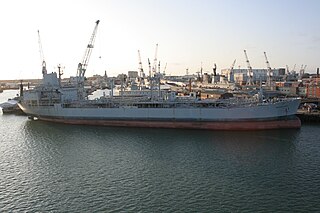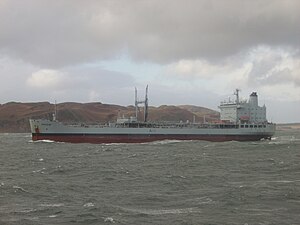
The Royal Fleet Auxiliary (RFA) is a naval auxiliary fleet owned by the UK's Ministry of Defence. It is a component of His Majesty's Naval Service and provides logistical and operational support to the Royal Navy and Royal Marines. The RFA ensures the Royal Navy is supplied and supported by providing fuel and stores through replenishment at sea, transporting Royal Marines and British Army personnel, providing medical care and transporting equipment and essentials around the world. In addition the RFA acts independently providing humanitarian aid, counter piracy and counter narcotic patrols together with assisting the Royal Navy in preventing conflict and securing international trade. They are a uniformed civilian branch of the Royal Navy staffed by British merchant sailors. The RFA is one of five RN fighting arms.
RFA Brambleleaf (A81) was a Leaf-class small tanker of the Royal Fleet Auxiliary (RFA), the naval auxiliary fleet of the United Kingdom.

RFA Orangeleaf was a Leaf-class fleet support tanker of the Royal Fleet Auxiliary (RFA), the naval auxiliary fleet of the United Kingdom, and which served with the fleet for over 30 years, tasked with providing fuel, food, fresh water, ammunition and other supplies to Royal Navy and allied naval vessels around the world.

RFA Fort Austin is a retired British Fort Rosalie-class dry stores ship of the Royal Fleet Auxiliary.

RFA Bayleaf (A109) was a Leaf-class support tanker of the Royal Fleet Auxiliary (RFA), the naval auxiliary fleet of the United Kingdom, which served with the fleet for 30 years, tasked with providing fuel, food, fresh water, ammunition and other supplies to Royal Navy vessels around the world.

RFA Fort Rosalie was the lead ship of her class of Royal Fleet Auxiliary fleet replenishment ships. Fort Rosalie was originally named RFA Fort Grange, but was renamed in May 2000 to avoid confusion with the now-decommissioned RFA Fort George. On 31 March 2021, the ship was withdrawn from service.
RFA Bayleaf (A79) was a Leaf-class support tanker of the Royal Fleet Auxiliary, and the second ship to bear the name.

RFA Brambleleaf (A81) was a Leaf-class support tanker of the Royal Fleet Auxiliary (RFA), the naval auxiliary fleet of the United Kingdom. Originally built as MV Hudson Deep she was chartered by the Ministry of Defence (MoD) in 1980.

RFA Olwen (A122) was an Ol-class "fast fleet tanker" of the Royal Fleet Auxiliary (RFA), the naval auxiliary fleet of the United Kingdom. She was the lead ship of her class, and launched in 1964 as RFA Olynthus, the second ship to bear this name.

RFA Olmeda (A124) was an Ol-class "fast fleet tanker" of the Royal Fleet Auxiliary (RFA) the naval auxiliary fleet of the United Kingdom. She was designed by the builders to meet specific requirements and be capable of maintaining “fleet speed”. When she entered service she was one of the largest and fastest ships in the RFA Fleet. Initially named Oleander, she was renamed after two years in operation.

RFA Tidespring (A75) was a Tide-class replenishment oiler of the Royal Fleet Auxiliary. As a replenishment oiler, her main purpose was to refuel other ships. The ship had a long career in the RFA, entering service in the early 1960s, and finally being decommissioned in 1991.

NRP Bérrio (A5210) was a fleet support tanker of the Portuguese Navy. She was built by Swan Hunter in 1969 at Hebburn, England as RFA Blue Rover (A270) of the Rover-class and from 1970 to 1993 was part of the British Royal Fleet Auxiliary. In 1982 during her British service she participated in the Falklands War.

The Fort Victoria or Fort II class is a class of replenishment oiler of the Royal Fleet Auxiliary, a role that combines the missions of a tanker and stores supply ship. As such they are designated auxiliary oiler replenisher (AOR). They are tasked with providing ammunition, fuel, food and other supplies to Royal Navy vessels around the world. There were two ships in the class, Fort Victoria and Fort George; the latter being taken out of service and despatched for scrapping at a Turkish breakers as a consequence of budgetary cutbacks.

The Fort Rosalie or Fort class of fleet replenishment vessel of the British Royal Fleet Auxiliary were designed to replenish Royal Navy taskgroups with various armaments and victualling stores while under way. Unlike the bigger Fort Victoria class, they supply dry stores and not fuel. RFA Fort Rosalie was originally known as Fort Grange but was renamed in 2000 to avoid confusion with the new Fort Victoria-class replenishment oiler RFA Fort George. Both ships were withdrawn from service and later sold in 2021.

The Leaf class is a class of support tanker of the Royal Fleet Auxiliary (RFA), the naval auxiliary fleet of the United Kingdom. The class is somewhat unusual as it is an amalgam of various civilian tankers chartered for naval auxiliary use and as such has included many different designs of ship. Leaf names are traditional tanker names in the RFA, and are recycled when charters end and new vessels are acquired. Thus, there have been multiple uses of the same names, sometimes also sharing a common pennant number.

RFA Wave Ruler is a Wave-class fast fleet tanker of the Royal Fleet Auxiliary (RFA) of the United Kingdom tasked with providing fuel, food, fresh water, ammunition and other supplies to Royal Navy vessels around the world.

RFA Wave Knight is a Wave-class fast fleet tanker of the Royal Fleet Auxiliary (RFA) of the United Kingdom tasked with providing fuel, food, fresh water, ammunition and other supplies to Royal Navy vessels around the world.

The Tide-class tanker (formerly the Military Afloat Reach and Sustainability (MARS) project) is a class of four fast fleet tankers that entered service with the British Royal Fleet Auxiliary from 2017. The 37,000 t ships provide fuel, food, fresh water, ammunition and other supplies to Royal Navy vessels around the world. Norway ordered a similar 26,000 t version with a 48-bed hospital and greater solid stores capacity, but reduced liquid capacity; it was delivered in November 2018 as HNoMS Maud two years after originally planned. The two classes are very similar but are not directly comparable due to large variance in capabilities delivered.

RFA Tideforce is a Tide-class replenishment tanker of the British Royal Fleet Auxiliary (RFA). Launched in 2017, the ship entered service with the RFA in 2019.

















